 |
|
 |
|
|
If your browser labels this site "Not Secure," click here.
|
|
2018
November
26
|
Has science been revolutionized in my lifetime?
A thought on rereading Nancy Pearcey and Charles Thaxton's
The
Soul of Science...
Two of the most important things in science today are software and DNA. Both of these are coded messages that cause things to happen in the physical world.
The notion of a coded message causing inanimate objects to do things would have been almost incomprehensible to most scientists 150 years ago. Philosophers would have seen it as a revival of medieval notions of magic.
But today it pervades science. We may have had a scientific revolution within my lifetime that is at least as big as the atomistic revolution (the shift from studying visible objects to things too small to see, such as cells and atoms) in the 1600s
and 1700s.
Philosophically, Aristotle's matter-form distinction, viewed two
centuries ago as a dusty relic of the Middle Ages,
is now the key to much of what scientists spend their days doing.
The stated purpose of
The
Soul of Science
is to give a Christian perspective on the history and philosophy of science, but what that
amounts to is simply a good historical perspective, since Christianity was so important in
most of the places where the history took place.
It is not an anti-evolution or young-earth book; it's a serious history of
science and I highly recommend it.
Permanent link to this entry


|
2018
November
22
|
Happy Thanksgiving!
Permanent link to this entry


|
2018
November
21
|
First glimpse of Comet 46P/Wirtanen
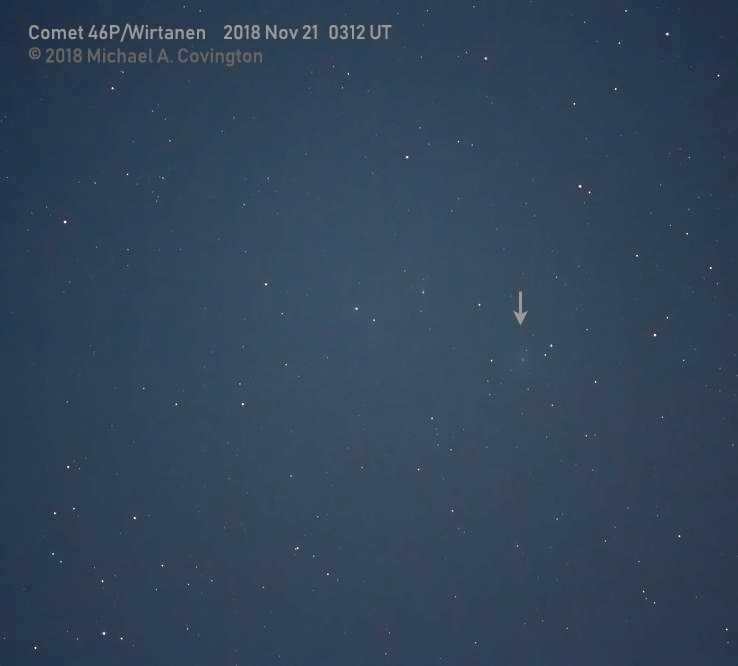
For the next couple of months, astronomers will be keeping an eye on
Comet 46P/Wirtanen, which is now visible in binoculars and
may even be visible to the unaided eye by Christmas.
It is unusual for a short-period comet, discovered some time ago, to become bright.
Bright comets are usually newly discovered ones that are making the
only pass near the sun that they have made for thousands of years.
This one, though, was discovered in 1948 and goes around every 5.4 years
(subject to alteration by the gravity of planets it passes near).
This time, it is passing unusually close to the earth (for a comet);
closest approach is 7.2 million miles (about 30 times as far as the moon)
on December 16.
At the time of the closest approach, it will be passing between the Pleiades
and Hyades, high in the sky.
The comet also
seems to be having an outburst, emitting more gas than usual, making it more
visible. It is currently 6th magnitude and was predicted to be 11th.
That means it is 100 times as bright as originally expected, and it's still
brightening.
The picture is poor because it was taken
with a small telephoto lens and a short exposure
under a nearly full moon.
I was also able to see the comet in 10×42 binoculars.
The image is a single 20-second exposure with a Zuiko 200-mm f/5 lens
and Canon 60Da on an iOptron SkyTracker.
The star Mu Fornacis is just out of the field at the bottom.
Permanent link to this entry


|
2018
November
20
|
Happy birthday, Sharon!
Permanent link to this entry


|
2018
November
19
|
An exhortation to Greek scholars
To students of the Greek language in the ancient world, and especially the New Testament:
Please do not use the term "Erasmian" to disparage the reconstruction of ancient Greek
pronunciation, or to give people the impression it's all just a speculation by Erasmus.
Although Erasmus
started the line of research,
nobody uses his system today. (He pronounced oi as wa.)
Current knowledge is summarized by
Sturtevant
and Allen.
It's based on a wide range of evidence, from transcriptions into other languages
to the physics of speech sounds. You can read their books for the details.
Most importantly, it's not just speculation, and it's not substantially disputed,
so it shouldn't have just one scholar's name pinned on it, especially a scholar whose
system we are no longer following in detail.
We do know how Plato and Aristotle pronounced their language.
Of course, Modern Greek pronunciation is quite different, and there is good evidence
(marshalled by Horrocks and
Schultz among others)
that the changes from ancient to modern were farther along in New Testament times
than had been supposed.
The practical issue is scribal errors. In order to understand discrepancies in ancient
and medieval manuscripts, scholars need to know whether two different spellings would
have represented the same sounds at the time. That is why we want to pin things down.
But throwing around the term "Erasmian" does nothing but obscure the issues.
Erasmus isn't involved in any current debate, and it's highly misleading to attach his
name to what is in fact a virtually undisputed consensus of scholars not including Erasmus!
One big point of confusion: Saying classical pronunciation was not used (exactly) in New
Testament times is not the same as saying that "Erasmian" pronunciation, meaning the post-Erasmus
scholarly consensus, is not the real classical pronunciation.
My qualifications: Recall that my Ph.D. is in lingustics, from Yale, and historical
linguistics was my original concentration, so I've studied things like this in considerable
depth. I can't claim to be totally au courant with the latest research on Greek, since this
hasn't been my main area for some time, but I can confirm that the basic consensus has not
been overturned.
Permanent link to this entry


|
2018
November
18
|
About this supposed "war on Christmas"...
I've never had anybody tell me not to say "Merry Christmas."
I gladly say "Happy Holidays" because (1) there's more than one holiday this season,
and (2) some people do not celebrate Christmas (my Jewish friends, for instance)
and I don't hold it against them.
The "war on Christmas" has been politicized — there are those who claim we need
to vote a certain way to regain the right to say "Merry Christmas." I can't detect
that we ever lost it.
It does have a slight basis in reality.
Occasionally, people in media or advertising, or other people imitating them,
have failed to call Christmas by its right name.
An example is that a few years ago, a TV station reported that people were going
to Bethlehem, Georgia, to mail their "holiday cards."
No. Only to mail Christmas cards. Bethlehem has no connection with
any other holiday.
I suspect that was cultural illiteracy on the part of the reporter,
who simply did not know the connection between Bethlehem, Christ, and Christmas.
There may have been others who deliberately suppressed the name Christmas,
which would indeed look like an anti-Christian gesture.
But my impression is that the practice of not calling Christmas Christmas peaked
more than ten years ago
and normalcy has returned.
If not, maybe some people need a little more cultural literacy.
But their ignorance does not constitute a "war on Christmas."
Permanent link to this entry
The Air Force scribbles on the sky
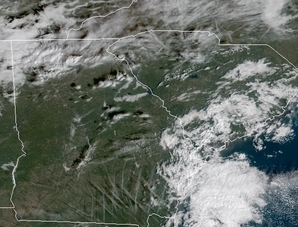
This morning's satellite weather map (from GOES-East) showed an unusual
crisscross pattern across South Georgia, which, as animated maps showed,
was blowing out into the Atlantic. Apparently, military exercises from
Moody Air Force Base produced contrails, and atmospheric conditions made
them prominent and persistent.
I joked that they should attempt skywriting with 100-mile letters.
That would constitute 456,192,000-point type, if I've done the calculation
correctly.
Permanent link to this entry


|
2018
November
15
|
Still more new dogs and old tricks
The goal of my observing session on November 10 was to make sure I could
autoguide with the ASI120MM-S camera (not yet used for that), 6-cm f/4 guidescope,
and OpenPHD (PHD2) software under Linux.
The imaging instrument was my
AT65EDQ refractor (6.5-cm f/6.5) and unmodified Nikon D5300 camera.
So I continued "teaching new dogs old tricks," photographing familiar objects
so I could evaluate the results. (Old tricks won't continue much longer; we have
a bright comet coming, as well as the ongoing shenanigans of McNeil's Nebula.)
I'm happy to report that the autoguiding worked very well, even though I'm not
through fine-tuning the settings. Compared to the very early model DMK camera that
I was using previously, the ASI120MM-S could see a lot more stars.
Also, the software interfaced with it directly rather than through INDI.
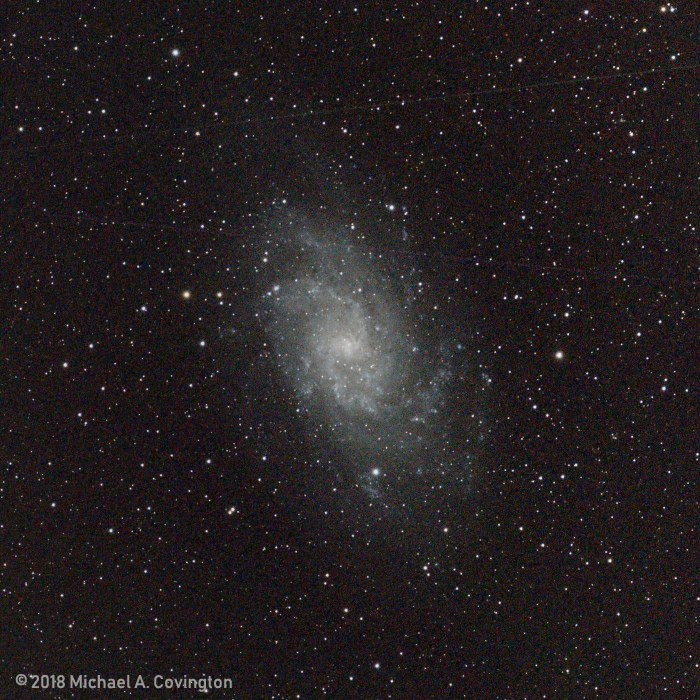
Here's the galaxy M33, a stack of ten 3-minute exposures at ISO 200.
Not bad for a picture taken in town under magnitude 4.3 skies.
Permanent link to this entry
Star cluster M34
Right after M33 in Messier's catalogue comes M34, this squarish star cluster in Perseus,
a fine sight in binoculars:
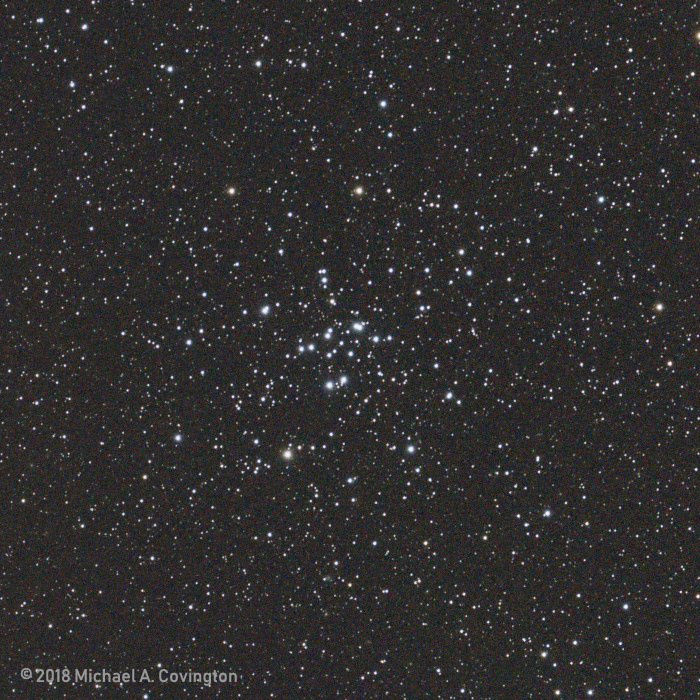
Same equipment and technique as the previous picture.
Permanent link to this entry
A quick look at the Pleiades
I only took four 3-minute exposures of the Pleiades, partly because the autoguiding
wasn't going so well due to turbulent air (though you can't see it here), and partly
because I wanted to move on to McNeil's Nebula (scroll down). But here's a presentable image:
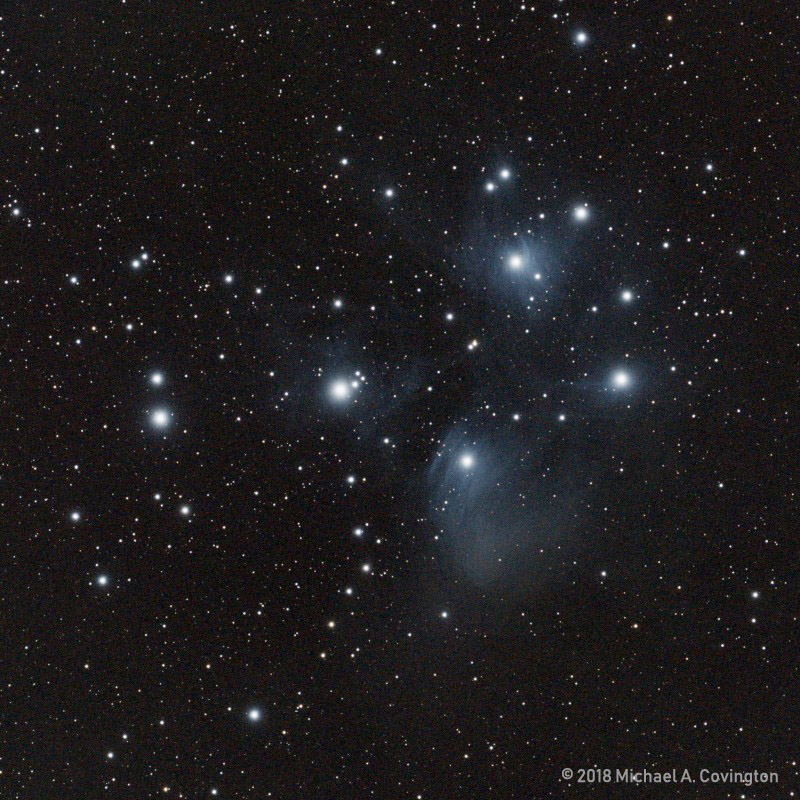
Permanent link to this entry


|
2018
November
12
|
McNeil's Nebula has disappeared
A
bulletin from the British Astronomical Association
informs me that
McNeil's Nebula,
a faint nebula in the field of M78,
has disappeared from view and, as of November 6,
could not be imaged with telescopes as large as 610 mm (24 inches).
This is of course a variable nebula, one illuminated by a star whose brightness fluctuates.
In the pictures below, you can see that I successfully photographed it with my 8-inch
in 2016, but two nights ago, my 6.5-cm (2.6-inch) couldn't get it, which doesn't prove it
is all that faint; I want to go at it again with the 8-inch telescope soon.
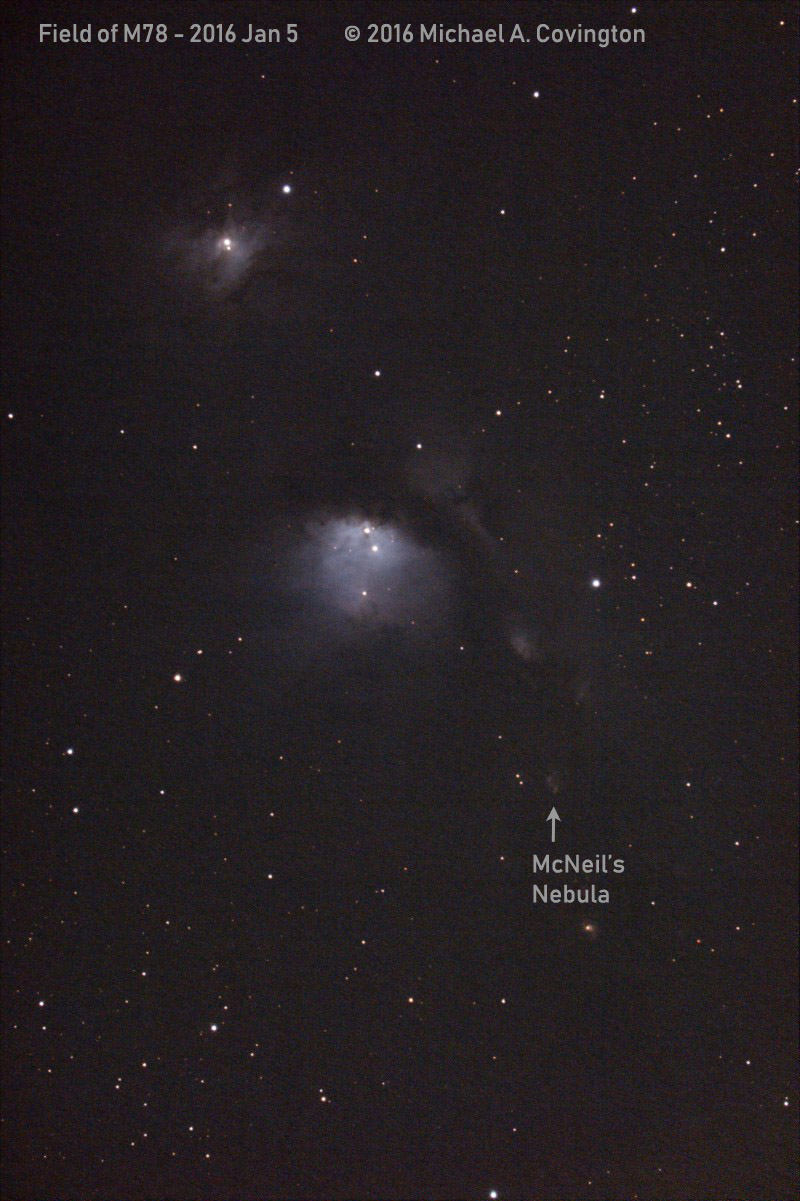
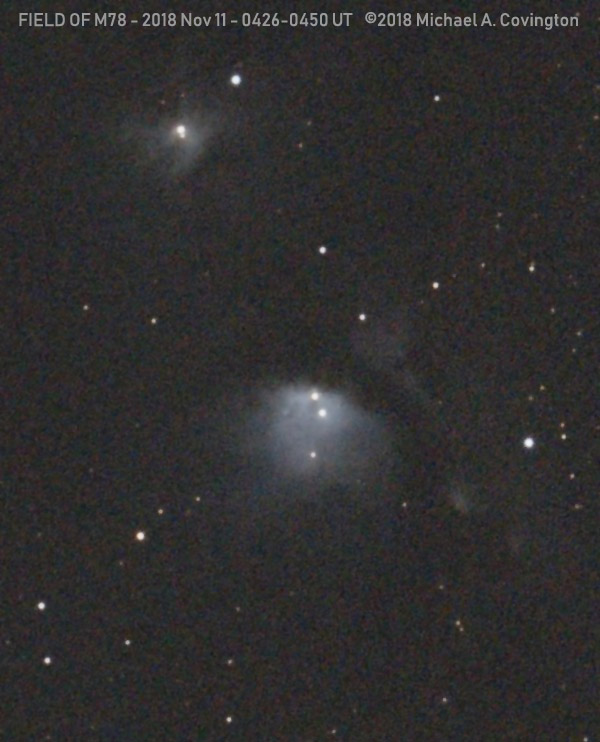
The first picture is a stack of fifteen 1-minute exposures with a Celestron 8 EdgeHD at f/7
and a Canon 60Da at ISO 800. The second is a stack of seven 3-minute exposures with an AT65EDQ
refractor (6.5-cm f/6.5) and a Nikon D5300 at ISO 200.
Permanent link to this entry


|
2018
November
11
|
Armistice
Today, on Veterans' Day, which this year
is also the centenary of the end of the Great War,
I want to thank everyone who risked
or lost their life in defense of their country.
As best I can make out, World War I was a brawl that started with no noble cause and,
like most brawls, ended
with everyone fighting in self-defense.
One thing that emerged from it was the new concept of preventing war,
not by giving in to those who want to pillage you,
but by preventing misunderstandings and heading off conflicts of interest.
I am happy to be involved today in defense research that aims to prevent war.
And I am thankful that my freedom today was earned by so many who risked,
and in some cases suffered, death in order to defend it.
Permanent link to this entry


|
2018
November
9
|
You need spudgers!
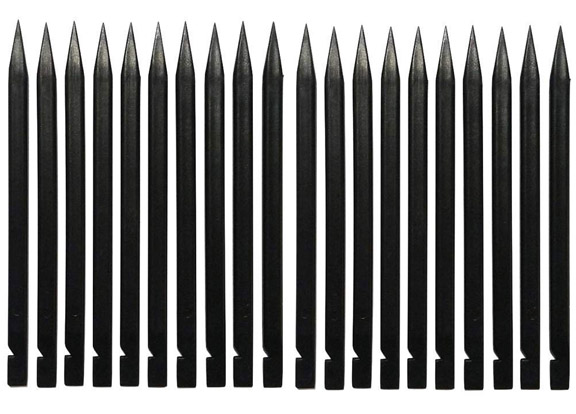
A spudger is a 21st-century tool that I don't know how we ever did without.
It's a plastic prying tool for popping open plastic enclosures
without scratching them, getting batteries
out of holders, and a myriad other uses.
I recommend
this set of 20 for $8.99
from Amazon.
It's a round chisel on one end and a straight chisel on the other end,
with a hook whose exact purpose I have not yet divined.
Put a couple of spudgers in every pencil cup.
You'll use them constantly.
Permanent link to this entry
Through Nikon eyes
For comparison to last month's tryout of my Nikon 180-mm lens with a Canon 60Da,
I have also tested it with my Nikon D5300.
The D5300 has an inherently higher-quality sensor than the Canon but is less
sensitive to the deep-red light of hydrogen nebulae.
But it does see nebulae reasonably well, especially the blue hydrogen-beta
emission, so that nebulae we thought of as red come out purplish or blue.
Here's the Veil Nebula, a high-temperature supernova remnant with lots of
hydrogen-beta:
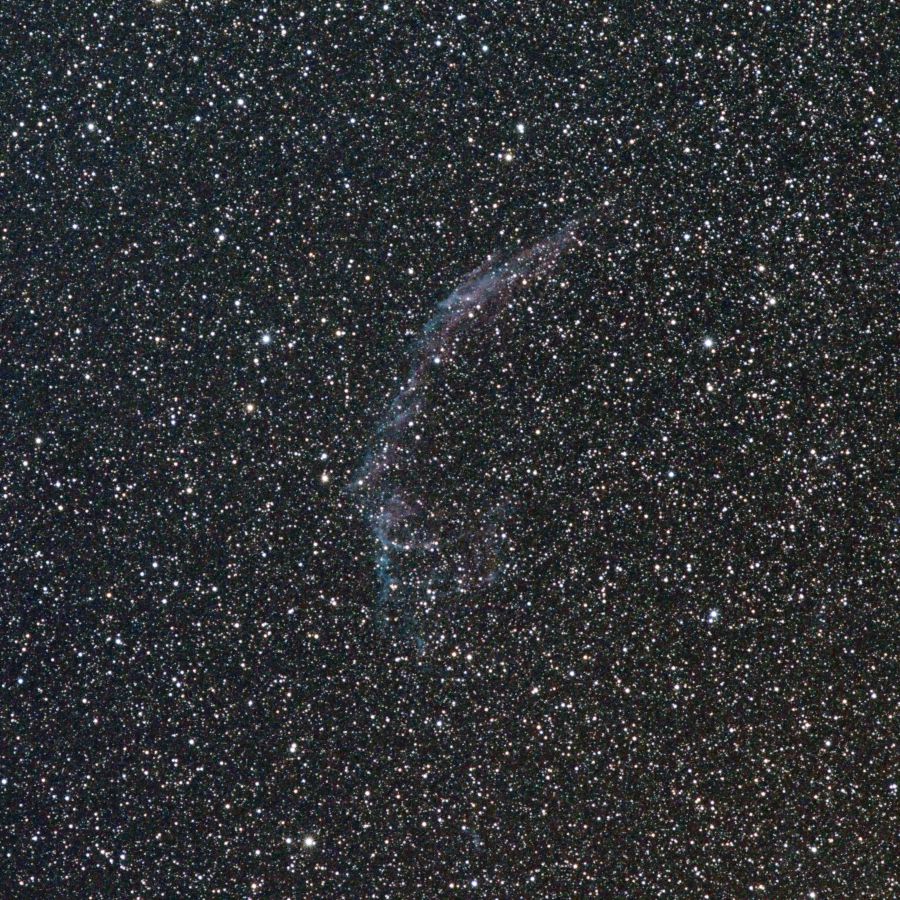
Here's the "Pac-Man nebula," NGC 281, which I haven't photographed before:
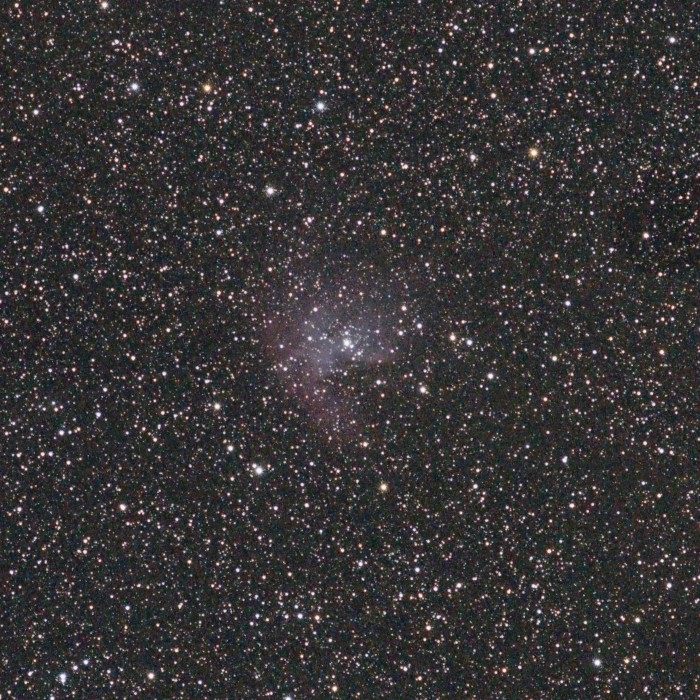
And here's the galaxy M33, which I've photographed many times, but I was surprised
to get such a good view in town:
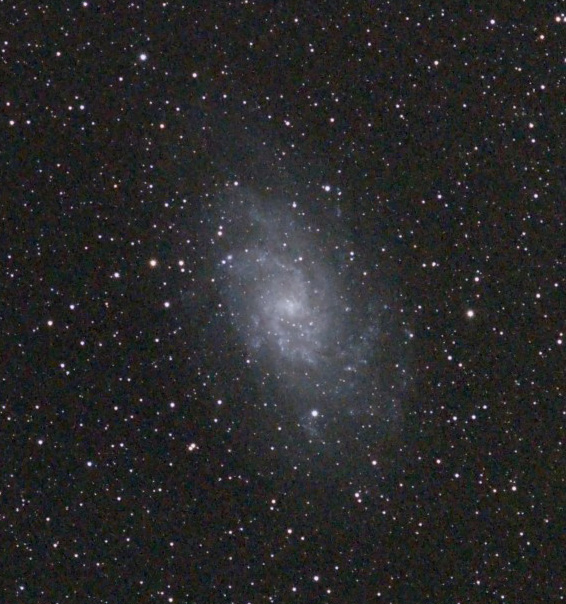
Each is a stack of ten 2-minute exposures at ISO 200, 180-mm lens at f/4.
Permanent link to this entry


|
2018
November
8
|
43 years
Today marks 43 years since Melody and I met.
I've told the story of our meeting several times
in the Daily Notebook.
4300 more years would not be enough!
Permanent link to this entry
Short notes on recent events
My new book, Digital SLR Astrophotography
(2nd ed.), hasn't even made it to North America yet,
but I've written plenty of
updates and additional notes,
which will interest you even if you don't have the book. Enjoy!
On Saturday I went to the Stone Mountain Hamfest and found it still diminishing,
roughly half the size it was when I first attended it in 1988, or a little less than half,
but still worthwhile. I bought a cigar box full of IF transformers, one of which will
supply a replacement for my Hallicrafters receiver. And a few fuse holders.
And nothing else. Nowadays eBay and Amazon give us an efficient market for
everything.
We've just had an election, which threatened to include the spectacle of
Georgia's chief election official, Secretary of State Brian Kemp, certifying that he, candidate Brian Kemp,
had been elected governor by a 50.3% majority.
At least he has had the good sense to resign prior to doing the certification.
No reflection on his personal honesty, but I don't think the person who runs the
elections should be eligible to be a candidate for any office except re-election
to his own.
Apart from that, I have nothing to say about politics.
It is too much like football. People take sides for the sake of taking sides
and despising the other side.
Is anyone interested in solving problems rather than despising people?
More astrophotos tomorrow.
Permanent link to this entry


|
2018
November
4
|
More new dogs and old tricks
I know it seems I'm taking the same astronomical photographs over and over,
but what I'm doing is a shakedown cruise, so to speak, of some new configurations
of equipment that I want to be ready to take to Deerlick or other sites without
further preparation. So I'm photographing familiar objects to make sure everything
works well and I know the best settings.
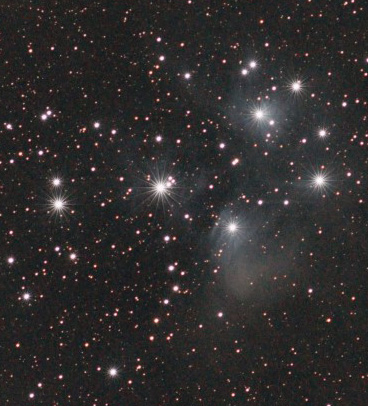
Here you see the Pleiades, with interstellar dust.
The "rig," as they would say in ham radio, is a Celestron AVX mount carrying a
Nikon 180-mm f/2.8 ED AI lens from days of yore, set to f/4, with a Nikon D5300
camera body.
This is a stack of ten 2-minute exposures at ISO 200 without guiding corrections.
The catch is, some time during the observing session, after I had taken flat fields
and some of the pictures, a dust mote got on the sensor.
So the pictures from this run are going to be cropped fairly tightly to exclude
the dust mote. Stand by for more.
Permanent link to this entry
Pushing an iOptron SkyTracker to its limits
I've told you about my iOptron SkyTracker before; it's a portable tracking mount for a
camera. But how well does it track the sky?
I've been testing it and have found that its total periodic gear error is
60 to 70 arc-seconds [corrected]
(a bit much, considering the high quality construction; iOptron
says it's at the high end of their range but not actually defective).
That results in a maximum error (discrepancy between desired and actual motion)
of about 25 arc-seconds per minute of time; often less.
And that is quite tolerable. I find I can get good 30-second exposures with a 200-mm lens,
where each pixel is about 4.5 arc-seconds.
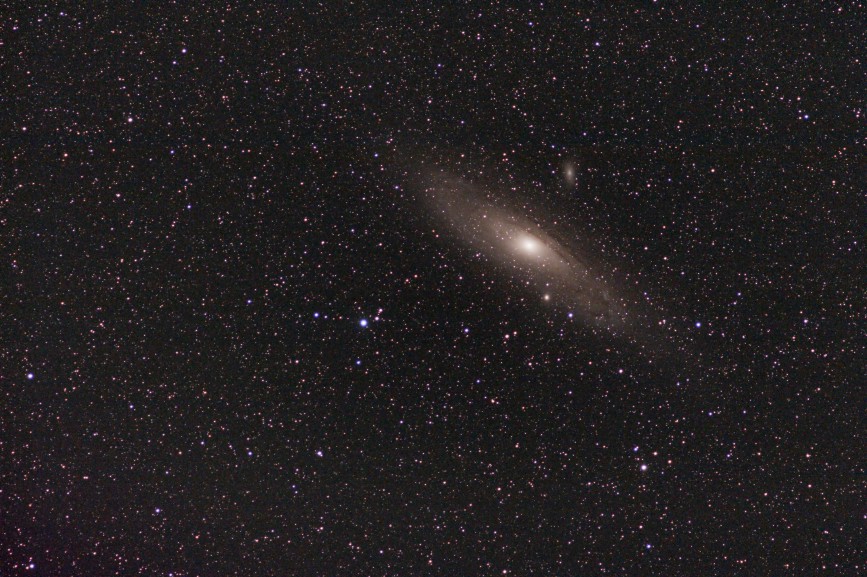
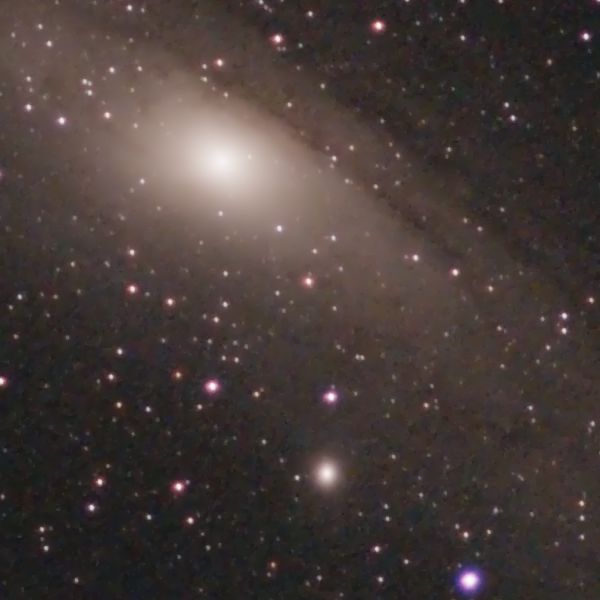
Here's a stack of 13 30-second exposures of the Andromeda Galaxy (M31) with a Zuiko 200-mm
f/5 lens (the one I wrote about last month) and a Canon 60Da.
The enlargement shows the picture at full resolution so you can see that the
tracking is satisfactory.
Of course, the images were stacked using an algorithm that discards outliers,
so brief tracking errors have no effect.
Permanent link to this entry


|
|
|
This is a private web page,
not hosted or sponsored by the University of Georgia.
Copyright 2018 Michael A. Covington.
Caching by search engines is permitted.
To go to the latest entry every day, bookmark
http://www.covingtoninnovations.com/michael/blog/Default.asp
and if you get the previous month, tell your browser to refresh.
Portrait at top of page by Sharon Covington.
This web site has never collected personal information
and is not affected by GDPR.
Some older pages that contain Google Ads may use cookies to manage the rotation of ads.
No personal information is collected or stored by Covington Innovations, and never has been.
This web site is based and served entirely in the United States.
In compliance with U.S. FTC guidelines,
I am glad to point out that unless explicitly
indicated, I do not receive substantial payments, free merchandise, or other remuneration
for reviewing or mentioning products on this web site.
Any remuneration valued at more than about $10 will always be mentioned here,
and in any case my writing about products and dealers is always truthful.
Reviewed
products are usually things I purchased for my own use, or occasionally items
lent to me briefly by manufacturers and described as such.
I am an Amazon Associate, and almost all of my links to Amazon.com pay me a commission
if you make a purchase. This of course does not determine which items I recommend, since
I can get a commission on anything they sell.
|
|
















